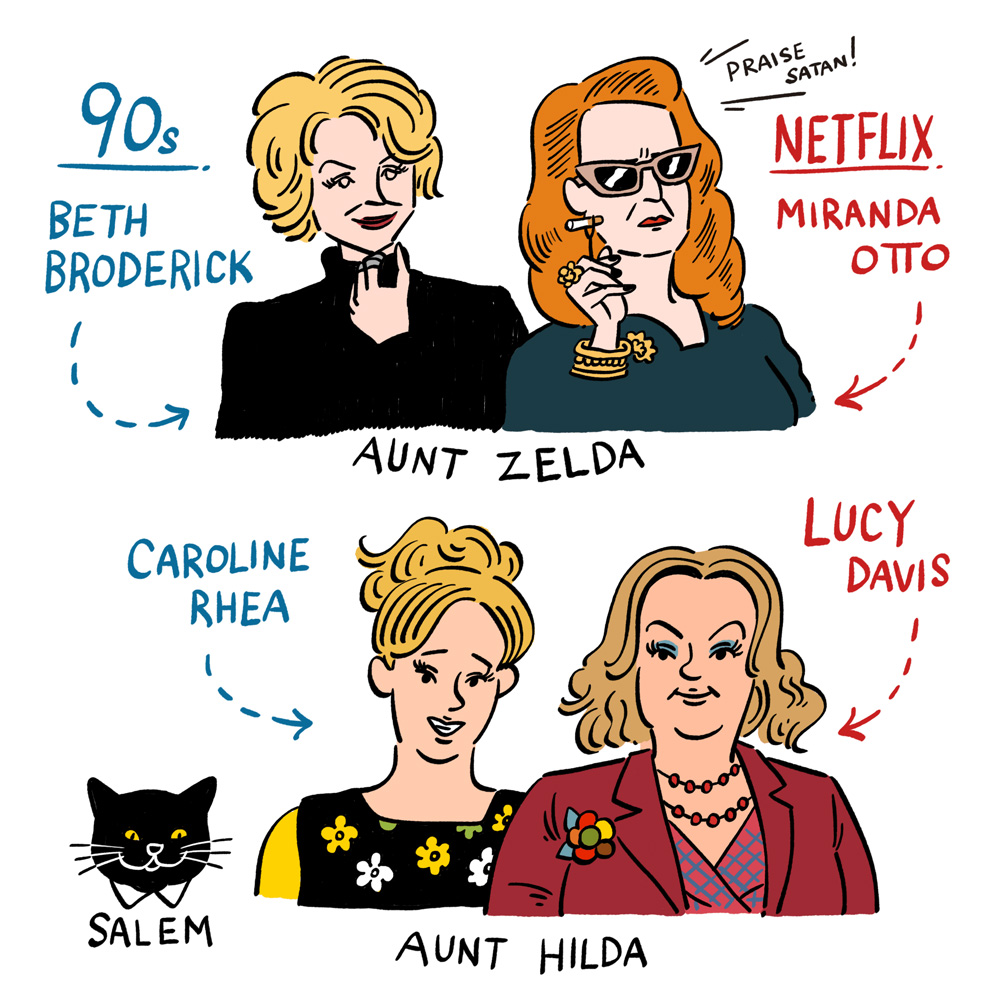Origins common to different works

One is based on the comedy version and the other is based on the horror version of the comic, so they have completely different tastes, but the origin remains the same. As mentioned above, the main premise of the plot is the same, and the main characters, including Sabrina, are also the same. There are many characters in similar positions, so it's interesting to compare the two. In both stories, Sabrina lives with her two aunts, sisters Zelda and Hilda, who are an irreplaceable family that supports and guides Sabrina, and sometimes helps her deal with troubles. In the 1990s version, the older sister Zelda was played by Beth Broderick and the younger sister Hilda was played by Caroline Rae. Zelda is an intelligent and calm aunt who is strict about the rules of the demon world, and her younger sister Hilda gives advice from a perspective relatively similar to Sabrina's.
The basic personalities and positions of the aunts remain the same in the NETFLIX version, but Zelda, played by Miranda Otto, has ambition behind her strictness, and Hilda, played by Lucy Davis, has an emphasis on her complex with her older sister. However, when faced with a difficult situation, Zelda takes bold action, Hilda listens to Sabrina's worries as if they were her best friend, and as a result of dealing with problems in her own way, she ends up doing something wrong. , it's fun because it reminds me of the 90's version. When you look at the common blood that flows through them, you feel that they are both the same "Sabrina." Both versions also feature Sabrina's human boyfriend, Harvey Kinkle. In the 90's version, it was promised that Sabrina's memory would be erased as soon as she realized she was a witch, but in the NETFLIX version, this only happens once. Although there is a difference in cheerfulness and seriousness, the hecticness of living a double life as a high school student and a resident of the demon world is still nostalgic and feels the same as the 90's version.
My favorite character is Salem, the black cat. In the 1990s version, Sabrina is a pet owned by the Spellman family, and begins speaking as soon as Sabrina turns 16. Like my aunts, I used to keep quiet until then. Although he is a silly character, he is not actually a cat, but a dangerous person who was made into a cat as punishment for plotting to conquer the world. She gives advice to Sabrina at various times, but she can also make matters worse. The sight of a black cat lying on a kitchen counter or table and talking while moving its tail and face can be said to be the trademark of this work.
It was this existence of Salem that drew me into `` Harry Potter and the Philosopher's Stone .'' This is because the chapter door illustration for Chapter 1 of ``The Philosopher's Stone'' is a scene where a cat is reading a map, and Harry's uncle, who will later take care of him, witnesses the cat making human-like gestures. The story begins to move from there. The cat's true identity is revealed to be a transformed Professor McGonagall, but I remember clearly being hooked at the beginning when the mysterious cat appeared. In the back of his mind was the black cat character who gave the teenager dubious advice. Cats are an essential part of the magical world. Salem in the NETFLIX version is Sabrina's familiar, and the "something" she meets in the forest is shaped like a black cat. It doesn't speak and appears as a normal cat, but since it's the first time we're shown how something strange turns into a cat, it doesn't look like an ordinary cat at all.

![Two Sabrinas, one comic [Mizumaru Kawahara's CINEMONOLOGUE Vol.34]](https://cinemore.jp/images/c39082937b207d68762c146054646cccbd1878dea006b39a64c19818241945c1.jpg)
